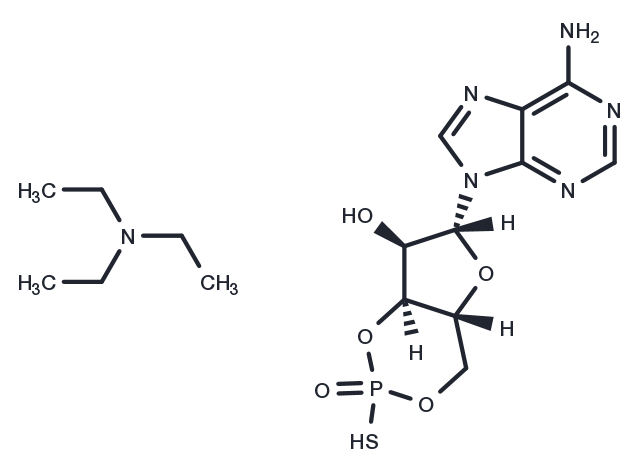Powder: -20°C for 3 years | In solvent: -80°C for 1 year


Rp-cAMPS triethylammonium salt is an analog of cAMP.It acts as a potent, competitive and cell-permeable antagonist of cAMP-induced activation of cAMP-dependent PKA I and II with Kis of 6.05 μM and 9.75 μM, respectively.

| Pack Size | Availability | Price/USD | Quantity |
|---|---|---|---|
| 500 μg | 35 days | $ 195.00 | |
| 1 mg | 35 days | $ 297.00 | |
| 5 mg | 35 days | $ 1,160.00 |
| Description | Rp-cAMPS triethylammonium salt is an analog of cAMP.It acts as a potent, competitive and cell-permeable antagonist of cAMP-induced activation of cAMP-dependent PKA I and II with Kis of 6.05 μM and 9.75 μM, respectively. |
| Targets&IC50 | PKA II:9.75 µM (ki), PKA I:ki: 6.05 µM |
| In vitro | A membrane-permeable competitive antagonist of cAMP that blocks PKA activation by binding to the regulatory subunits without dissociating the kinase holoenzyme inhibits synaptic plasticity[1]. |
| In vivo | The monosynaptic excitatory postsynaptic currents (EPSCs) induced at the PB-CeLC and BLA-CeLC synapses in tissue slices from arthritic rats were significantly reduced following treatment with Rp-cAMPS (10 μM, 15 min), whereas no reduction was observed in control neurons from healthy animals. This decline in EPSCs due to Rp-cAMPS is notably substantial when compared to the predrug artificial cerebrospinal fluid (ACSF) baseline levels measured in the identical neurons[1]. |
| Molecular Weight | 446.46 |
| Formula | C16H27N6O5PS |
| CAS No. | 151837-09-1 |
Powder: -20°C for 3 years | In solvent: -80°C for 1 year
You can also refer to dose conversion for different animals. More
bottom
Please see Inhibitor Handling Instructions for more frequently ask questions. Topics include: how to prepare stock solutions, how to store products, and cautions on cell-based assays & animal experiments, etc.
Rp-cAMPS triethylammonium salt 151837-09-1 Others Rp cAMPS triethylammonium salt Rp-cAMPS triethylammonium RpcAMPS triethylammonium salt inhibitor inhibit
